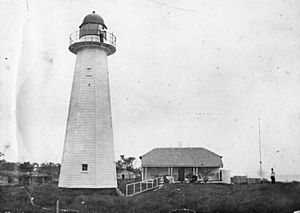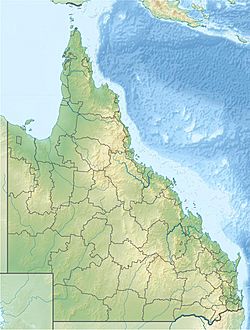Cowan Cowan Point Light facts for kids
 |
|
| Cowan Cowan Point Light in 1899 | |
|
|
|
| Location | Moreton Island Queensland Australia |
|---|---|
| Coordinates | 27°08′12″S 153°21′46″E / 27.13655°S 153.36282°E |
| Year first constructed | 1860s (first) 1874 (second) |
| Automated | 1950 |
| Construction | wooden tower |
| Tower shape | hexagonal tower with balcony and lantern |
| Markings / pattern | white tower and red lantern dome |
| Height | 5.5 feet (1.7 m), from 1867 10 feet (3.0 m) |
| Range | 12 nautical miles (22 km; 14 mi) |
| Admiralty number | K2859 |
| NGA number | 5844 |
| ARLHS number | AUS-295 |
The Cowan Cowan Point Light is a historic lighthouse on Moreton Island in Queensland, Australia. It's also known as the Cowan Cowan Light or Cowan Point Light. This important light helped ships navigate the waters near the western shore of Moreton Island for many years.
Contents
The Story of Cowan Cowan Point Light
The area around Cowan Cowan Point was first used as a pilot station in August 1848. A pilot station is where experienced sailors, called pilots, wait to guide ships safely into a harbor. This station was moved from Amity Point. Later, the pilot station moved again to Bulwer.
Building the First Lighthouse
The very first lighthouse at Cowan Cowan Point was built in the early 1860s. It was a wooden tower, about 18 feet (5.5 m) tall. This lighthouse used a large kerosene lamp with a reflector to shine a steady white light. In 1867, the tower was made taller, reaching about 34 feet (10 m). This happened at the same time the Comboyuro Point Light tower was built.
A New and Improved Lighthouse
In 1873, officials decided the lighthouse needed another upgrade. A new lighthouse was built in 1874 by two brothers, John and Jacob Rooney, from Maryborough. These brothers were famous for building lighthouses. They had already built the Sandy Cape Light in 1870.
The Rooney brothers also built the Lady Elliot Island Light around the same time. They even used the same design for the lantern part of both lighthouses. Later, they built other important lighthouses like Cape Bowling Green Light in 1874, Cape Capricorn Light in 1875, and Booby Island Light in 1890.
The lighting equipment inside the Cowan Cowan Point Light was also improved. The old equipment was moved to the Comboyuro Point tower, which was then moved to Burnett Heads. Today, that tower is known as the Old Burnett Heads Light. In 1883, the light was made even brighter by adding special lenses called condensing prisms. More building work was done in 1899, but we don't have many details about it.
Moving the Lighthouse Inland
By 1898, people noticed that the coastline was eroding, meaning the land was slowly being worn away by the sea. To protect the lighthouse and its nearby cottage, they were moved 635 feet (194 m) further inland in 1901.
In 1909, a description of the lighthouse said it was a wooden tower. It had a "fourth order dioptric apparatus," which is a type of lens system that helps focus the light. This light showed both red and white sections, and it could be seen from about 12 nautical miles (22 km; 14 mi) away.
Automation and Modern Light
The pilot station at Bulwer closed in 1909, but a signal station stayed open. In 1912, this signal station was moved to Cowan Cowan. For some time, the person who looked after the Cowan Cowan Light also operated the signal station.
In 1950, the lighthouse was updated to use acetylene gas. It became automated, meaning it no longer needed a person to operate it all the time.
Today, there is still an active light at the site. It's on a square metal tower that also acts as a daymark. A daymark is a special marker that helps ships navigate during the day. This one has orange-yellow squares on two of its sides. The light shines from about 30 feet (9.1 m) high. It flashes every two seconds and can be white, red, or green, depending on the direction. This modern light can be seen from about 10 nautical miles (19 km; 12 mi) away.


